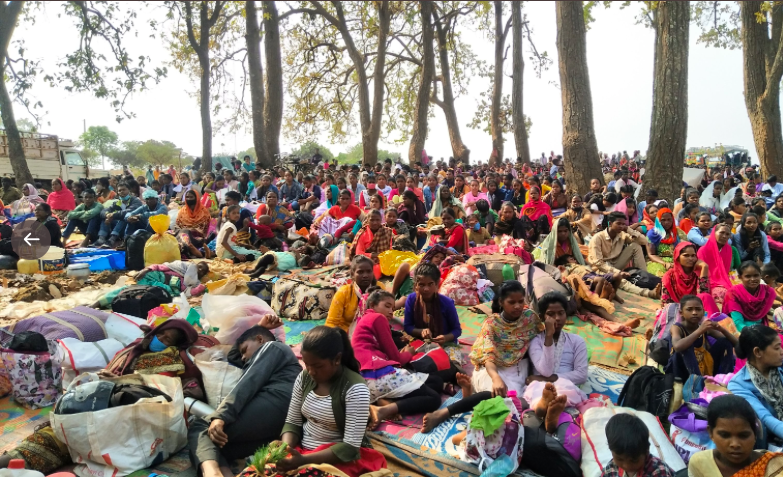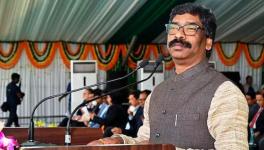Jharkhand: Adivasi Resistance Against Netarhat Firing Range Continues Even After 27 years

Image Credit--RoadScholarz Twitter.
Resistance against the central government project for the creation of the Netarhat firing range is still ongoing in Jharkhand, 27 years after the project was proposed, mounted by the tribal communities o the state. As part of the resistance, on March 22-23, adivasi residents from across villages gathered in Tattapani, in the Latehar district for a two day congregation to assert their commitment to the fight against land acquisition and tribal displacement for the creation of the firing range.
The struggle against the range has been ongoing since the 1990s, when the Centre had earmarked about 1,471 sq km in Netarhat Hills in Gumla and Latehar for field firing practice by the army, prior to the creation of what is now known as Jharkhand. Two state notifications dated November and March 25, 1992, under section 9(1) of the Manoeuvres Field Firing and Artillery Practices Act, 1938, notified this area for periodical field firing and artillery practice for 10 years. Separate notifications in 1992 and again in 2002, extended the field firing and artillery practice till 2022, as per reports.
Owing to enormous resistance in 1994, practice in the range and the displacement of over 2 lakh tribals across 245 villages was stopped, however, as the deadline for the renewal of the notification nears in 2022, the adivasi community on the ground is revamping their struggle.
Speaking with NewsClick about the widespread protests in 1994 and the current fears, James Herenj, state convenor of Jharkhand NREGA Watch, explained, “The area is inhabited by different adivasi communities-- largely the Oraon, Brijiya and the particularly vulnerable tribal group- Asurs, and Munda communities among many others. The struggle goes back to the 1990s even prior to the creation of Jharkhand. At that point in 1994, according to that notification, 245 villages were to be displaced—a number which has increased significantly by now—if the government decides to make the firing range operational. If our struggle would not have started, these communities would have had to be displaced. The struggle has been passed on from generation to generation, as a battle for our identities. We feel that if we give up this fight we will be rendered without our land.”
He went on to add, “In 1994, on March 22-23, the army had entered the area to practice weapons. As the forces entered the area, people from 245 villages—nearly a lakh—gathered in the area, with women at the frontline. The women laid down on the streets, stating that the forces will have to get past their dead bodies to take over the land. Our struggle has been a non-violent peaceful struggle since then.”
The latest congregation is an extension of their peaceful Satyagrahas, as claimed by the adivasis participating in the resistance. Economist Jean Dreze, who attended the congregation, told NewsClick, “It was an eye-opening experience to participate in the annual gathering of thousands of adivasis in Netarhat who are struggling against displacement by a firing-range project. For two days, men, women and children lived together in the shadow of the beautiful trees they were trying to protect and shared their thoughts on the way forward. Some brought rice, others firewood and others still lifted our spirits with a song. No one ordered anyone else around. The entire event was an inspiring symbol of democratic life and non-violent struggle.”
The community has stated that since the matter is not a state subject, they will continue their resistance until the project is cancelled.

Anil Manohar, who has been associated with the movement from its very beginning, said, “We had a meeting after our protest. In that meeting we decided we will file RTIs. There are 945 villages which could be affected now. We have decided to file 10 RTIs from each village and we will ask the government about whether the project will be rejected or not. This is our plan.”
The creation of the firing range was approved by the government under the section 9 of Maneuvers Field Firing and Artillery Practice Act 1938, allowing it to conduct its annual artillery shelling and firing practice here. Netarhat firing range was among the four such pilot ranges which was established in the country. Other places where it was set up include Rewa in Madhya Pradesh, Shameerpet in Andhra Pradesh and Koilat in Rajasthan.
Get the latest reports & analysis with people's perspective on Protests, movements & deep analytical videos, discussions of the current affairs in your Telegram app. Subscribe to NewsClick's Telegram channel & get Real-Time updates on stories, as they get published on our website.
























